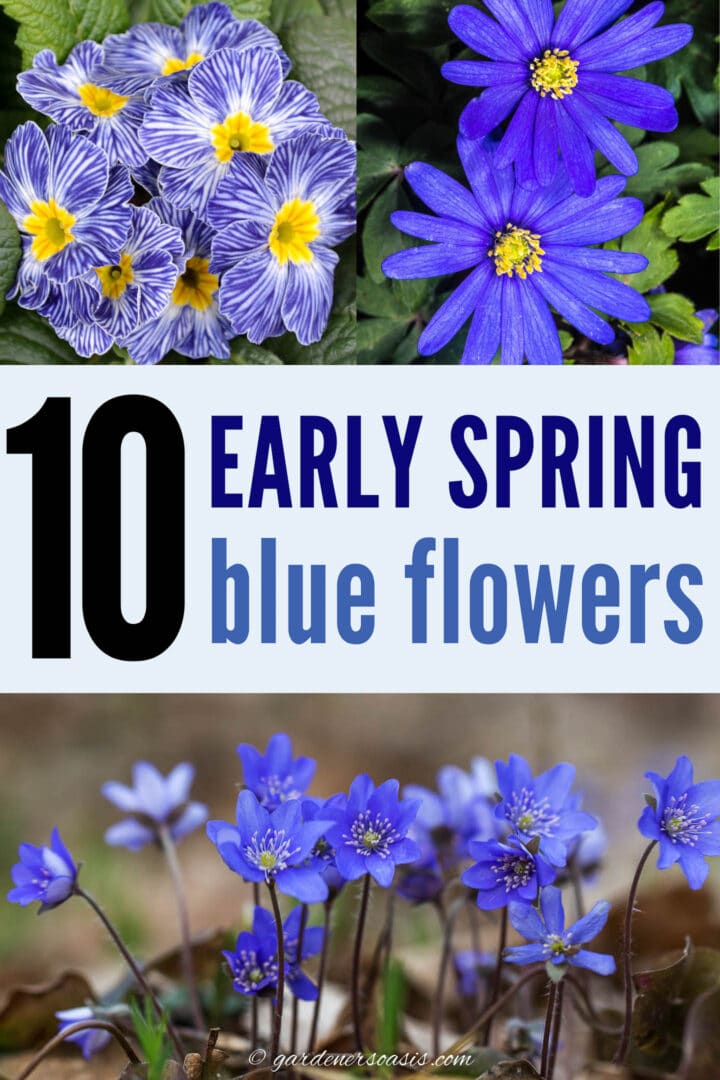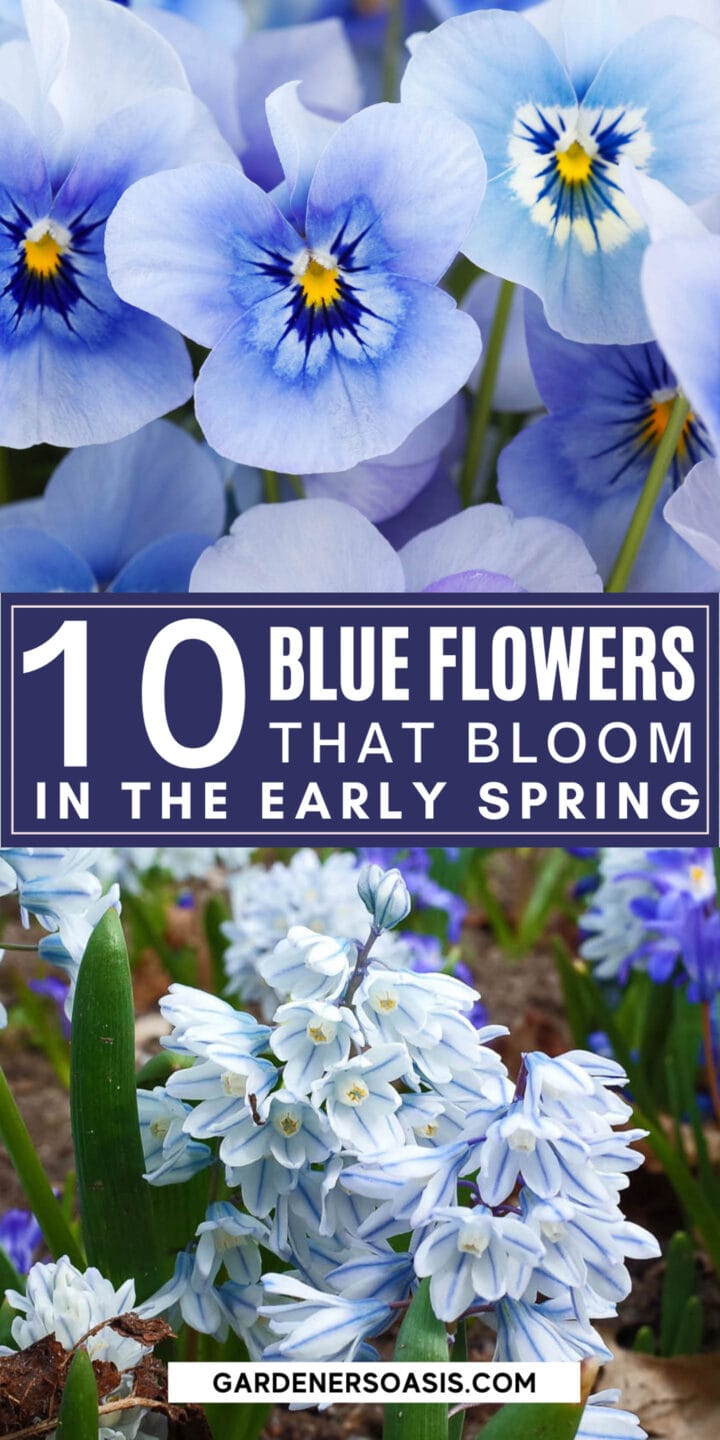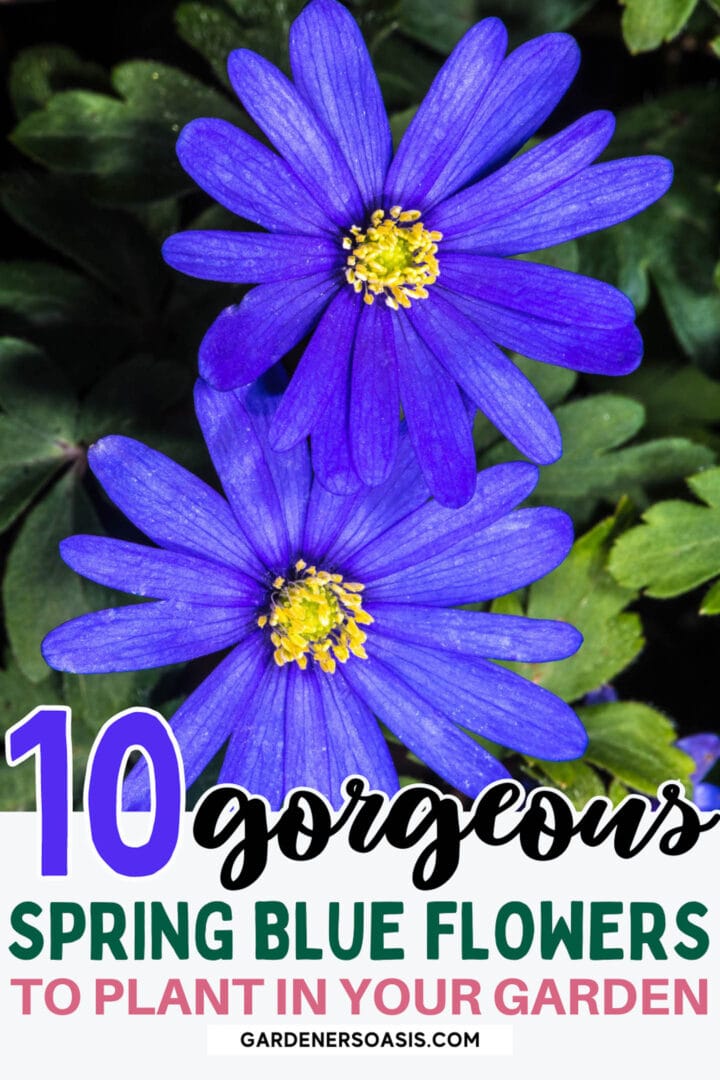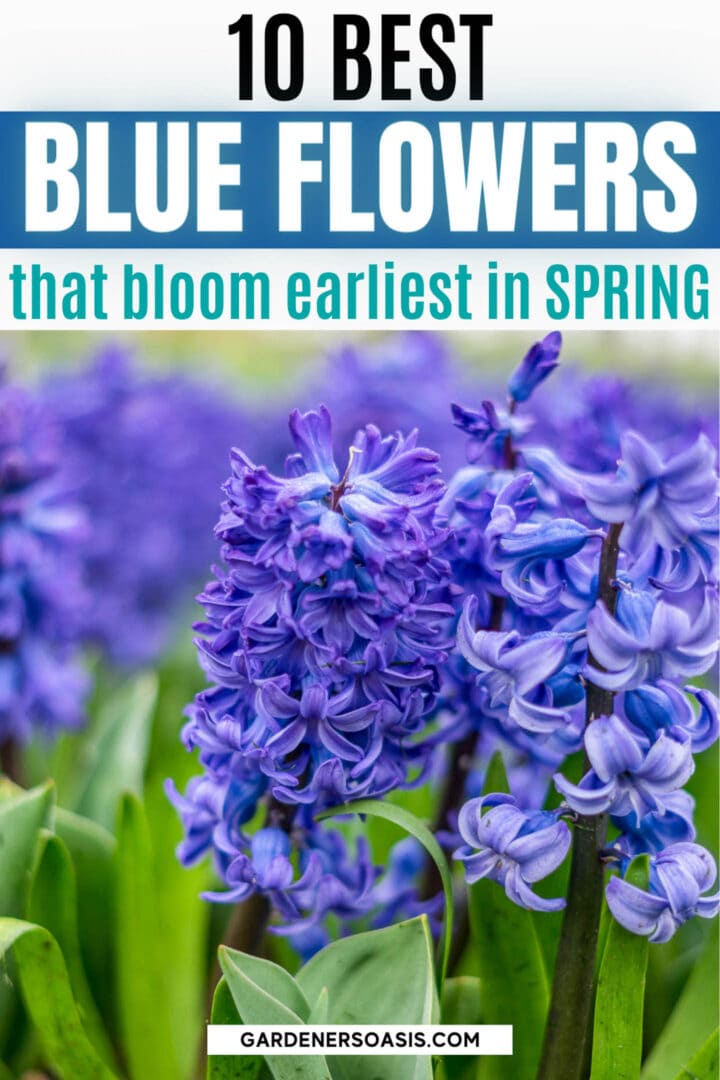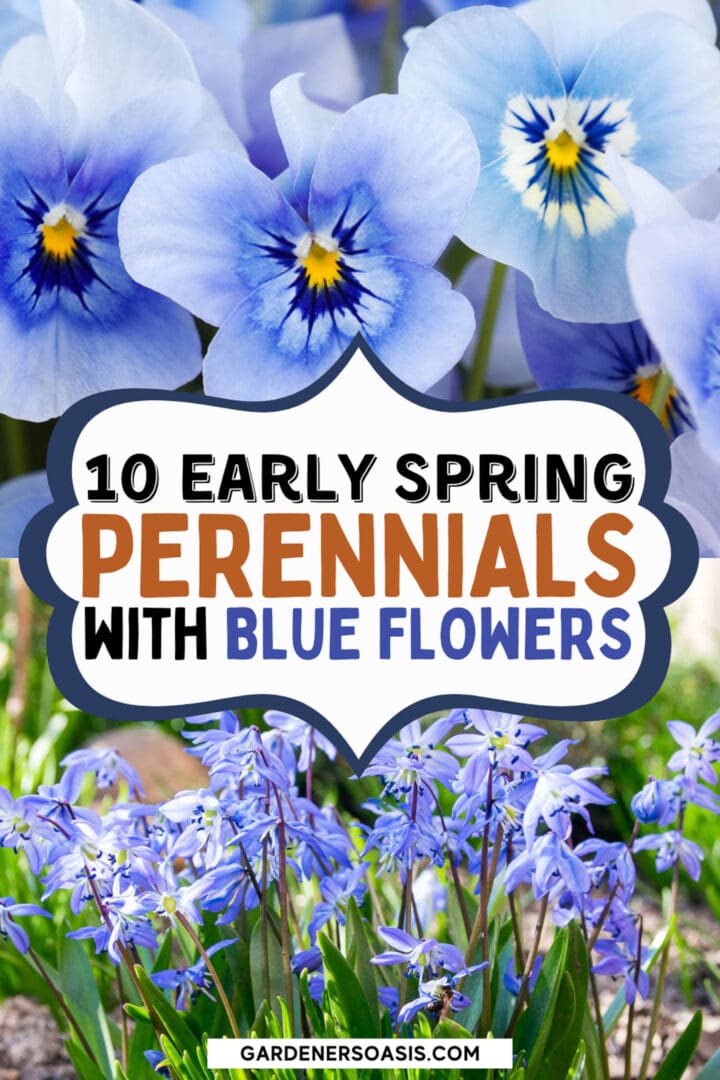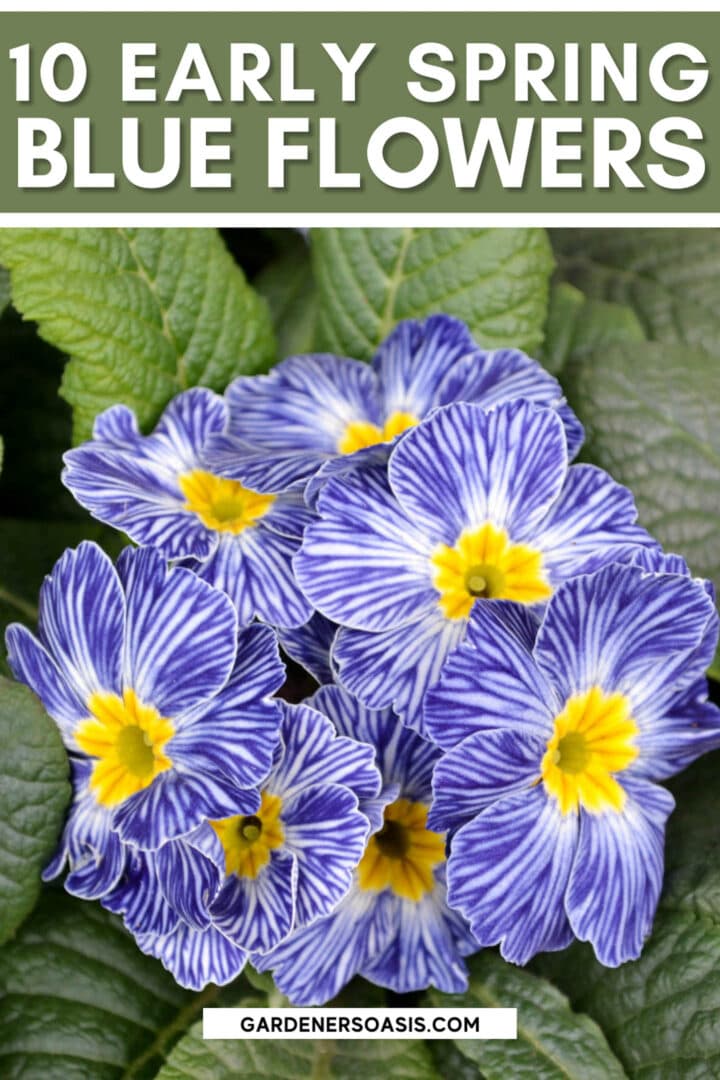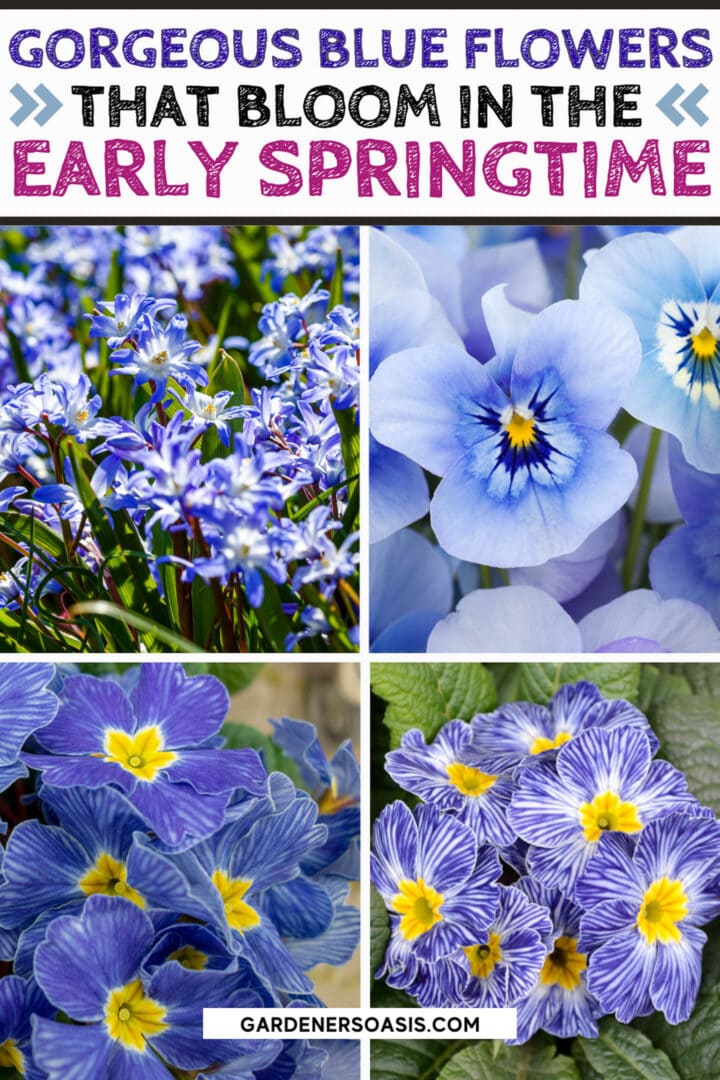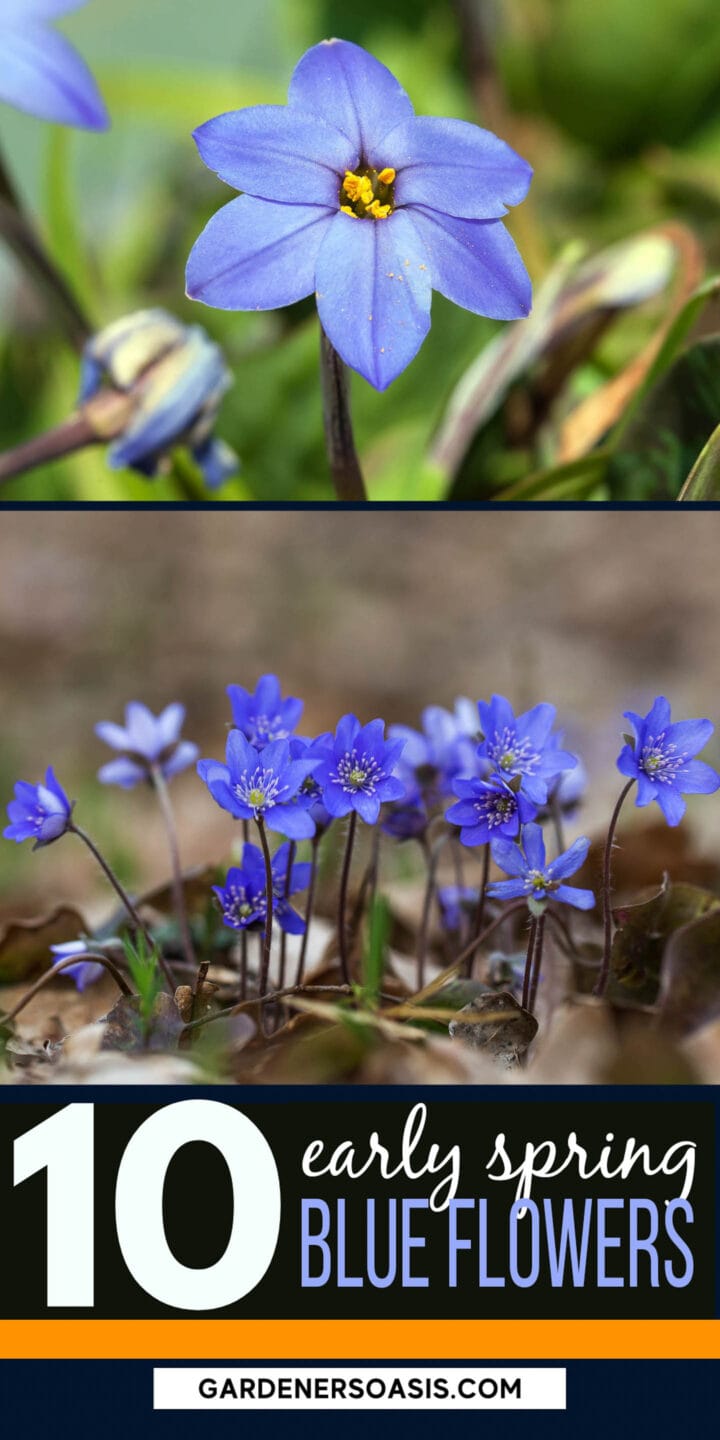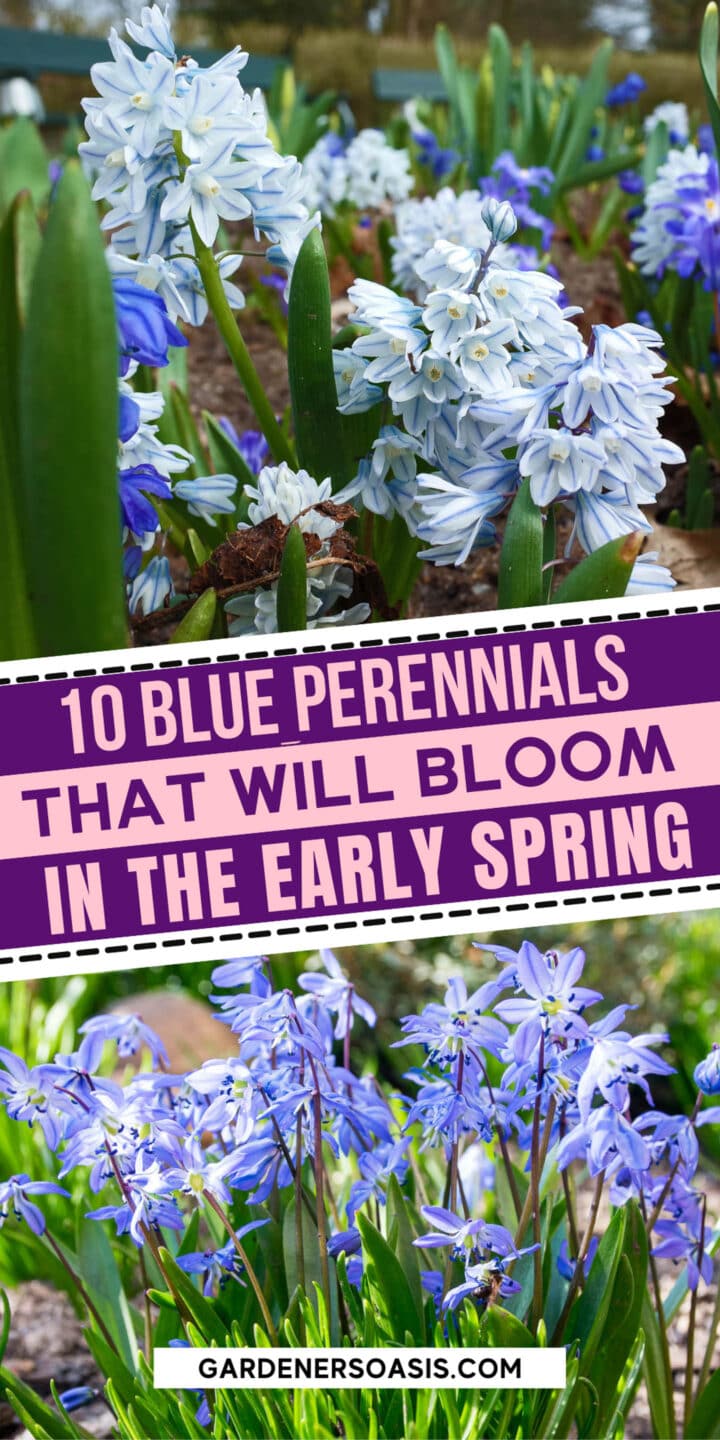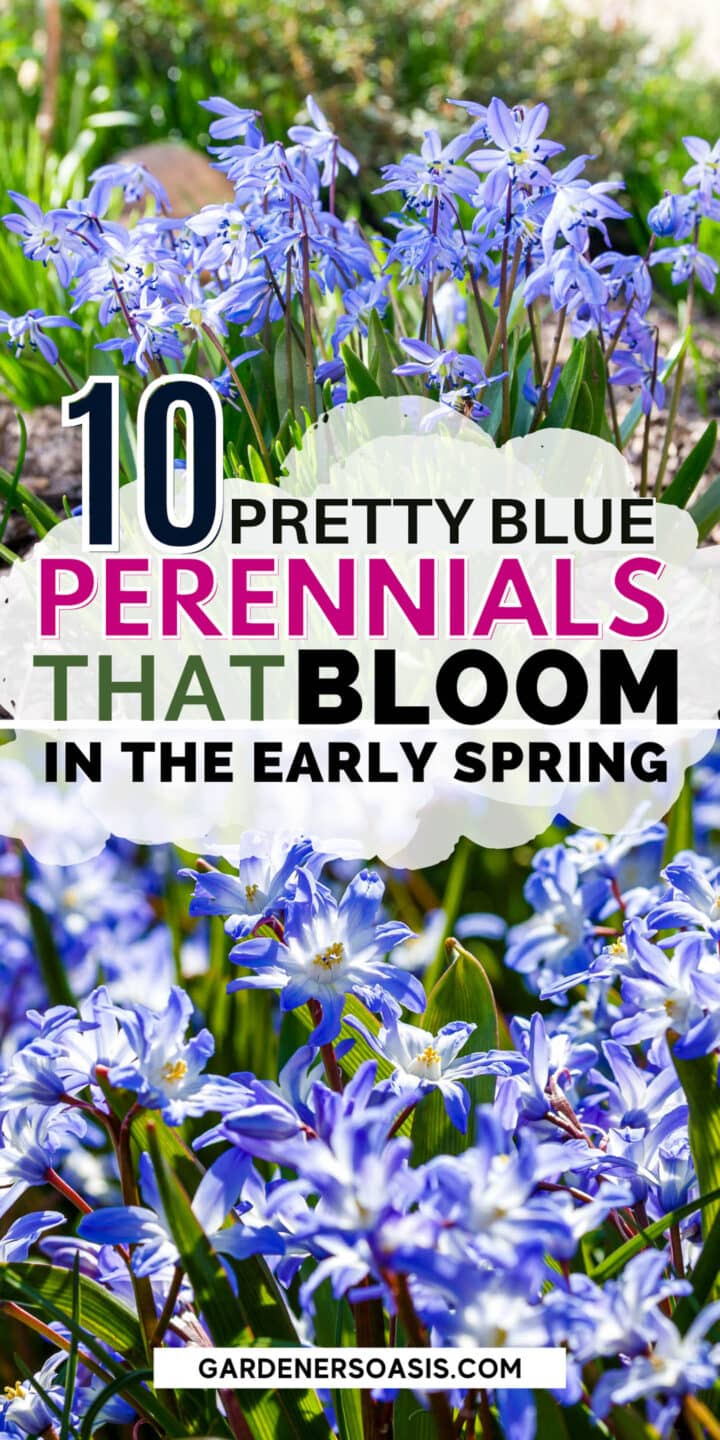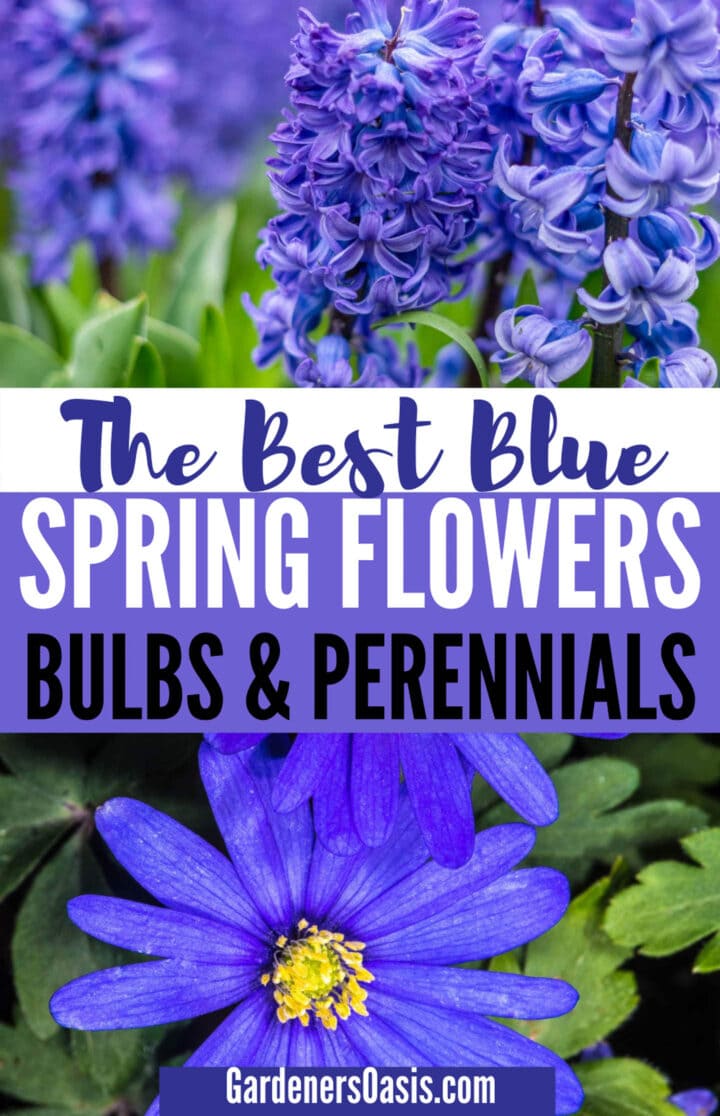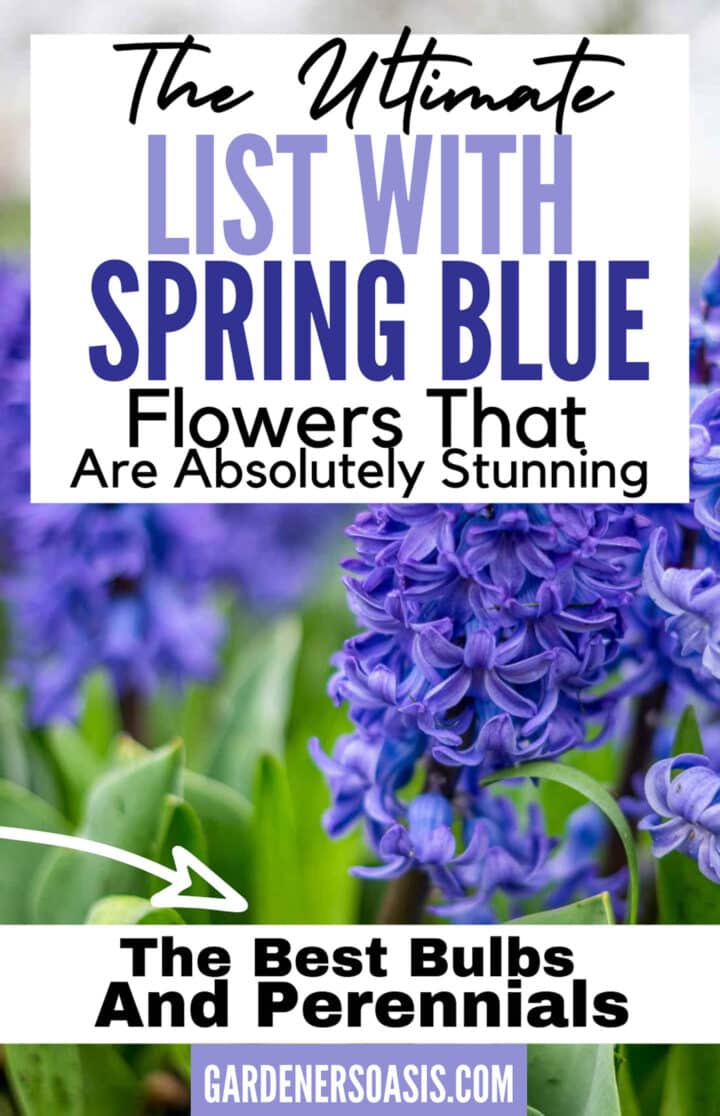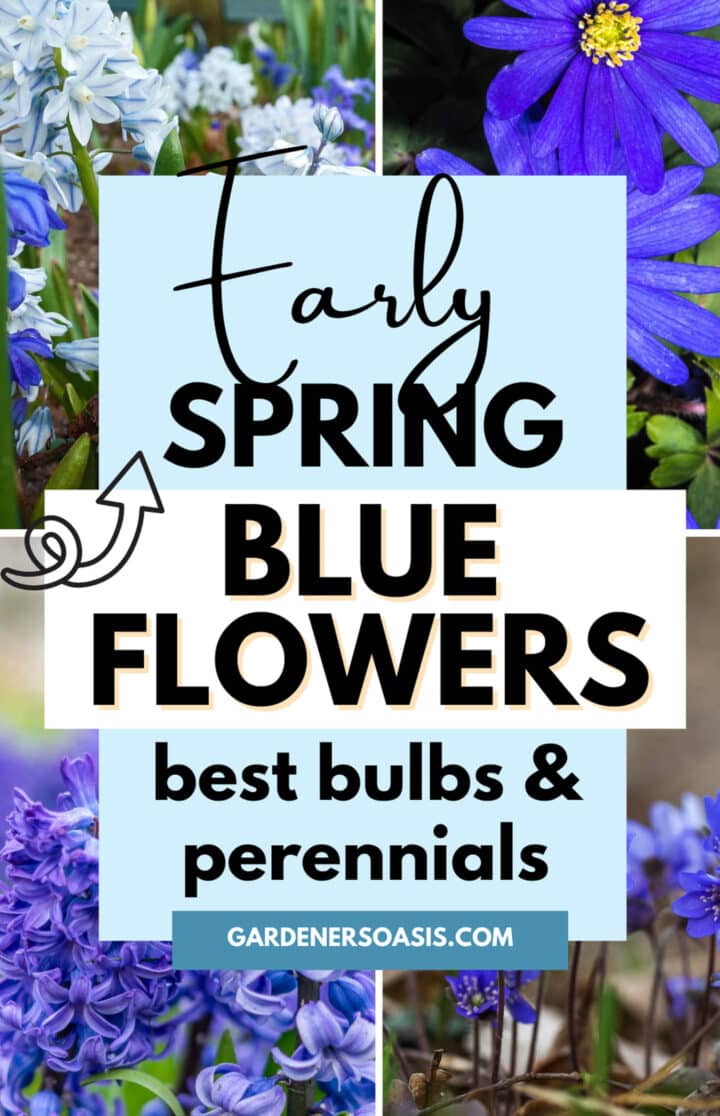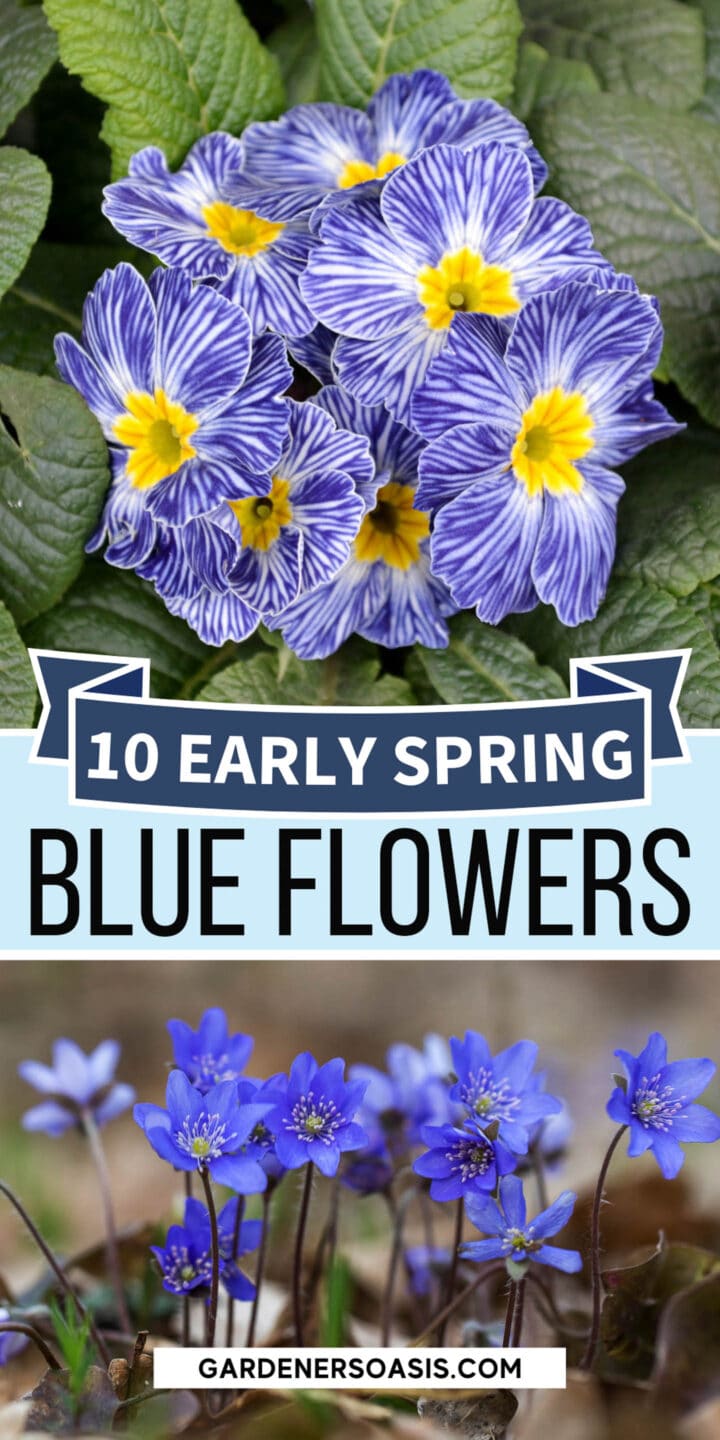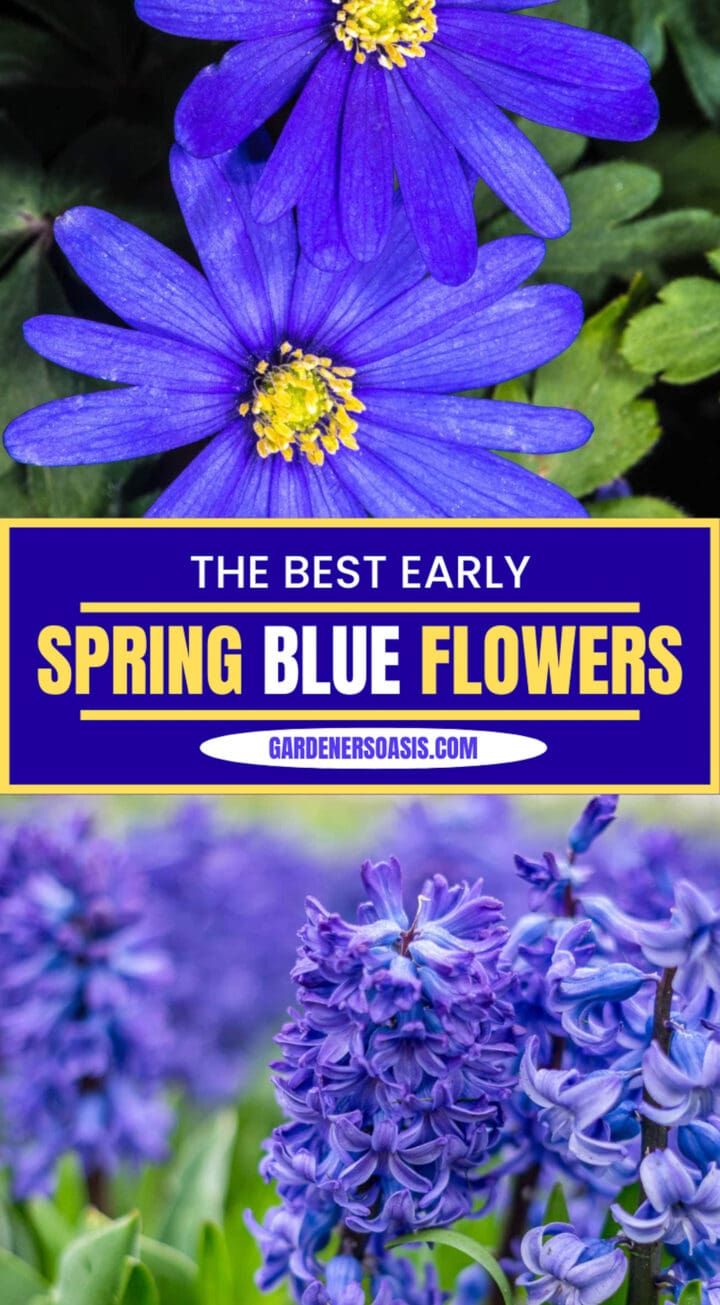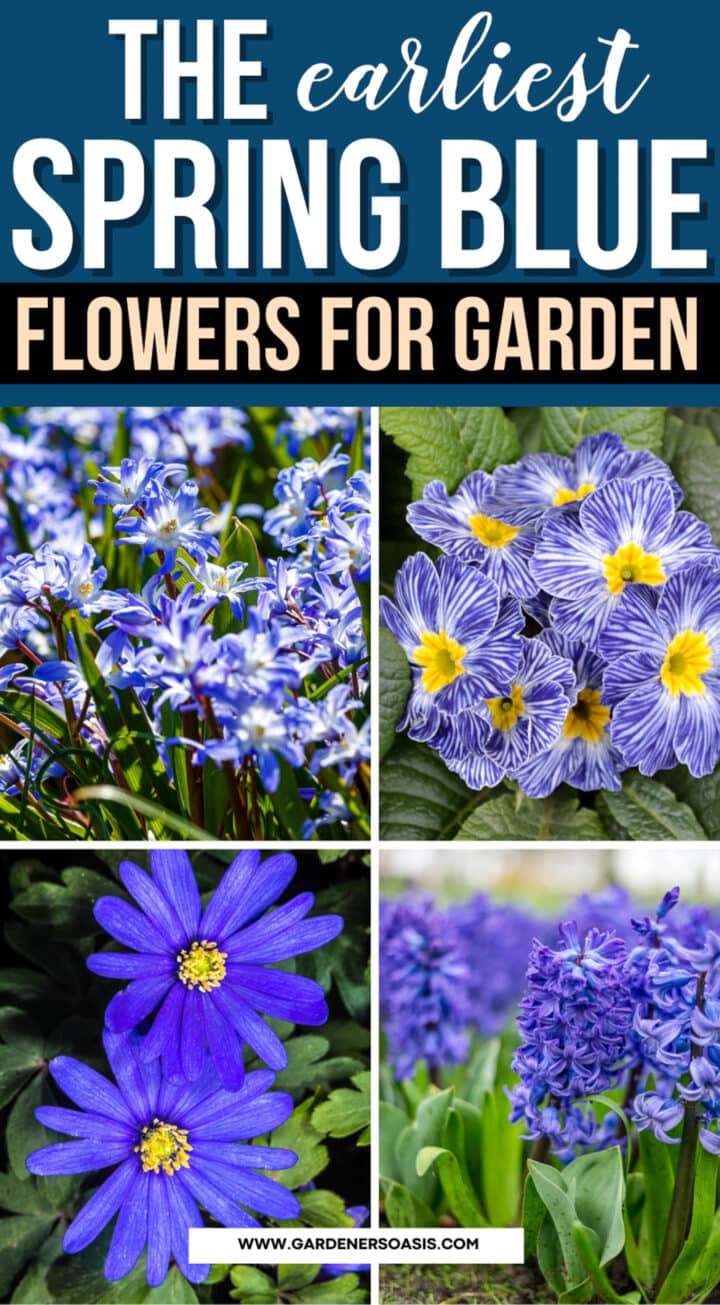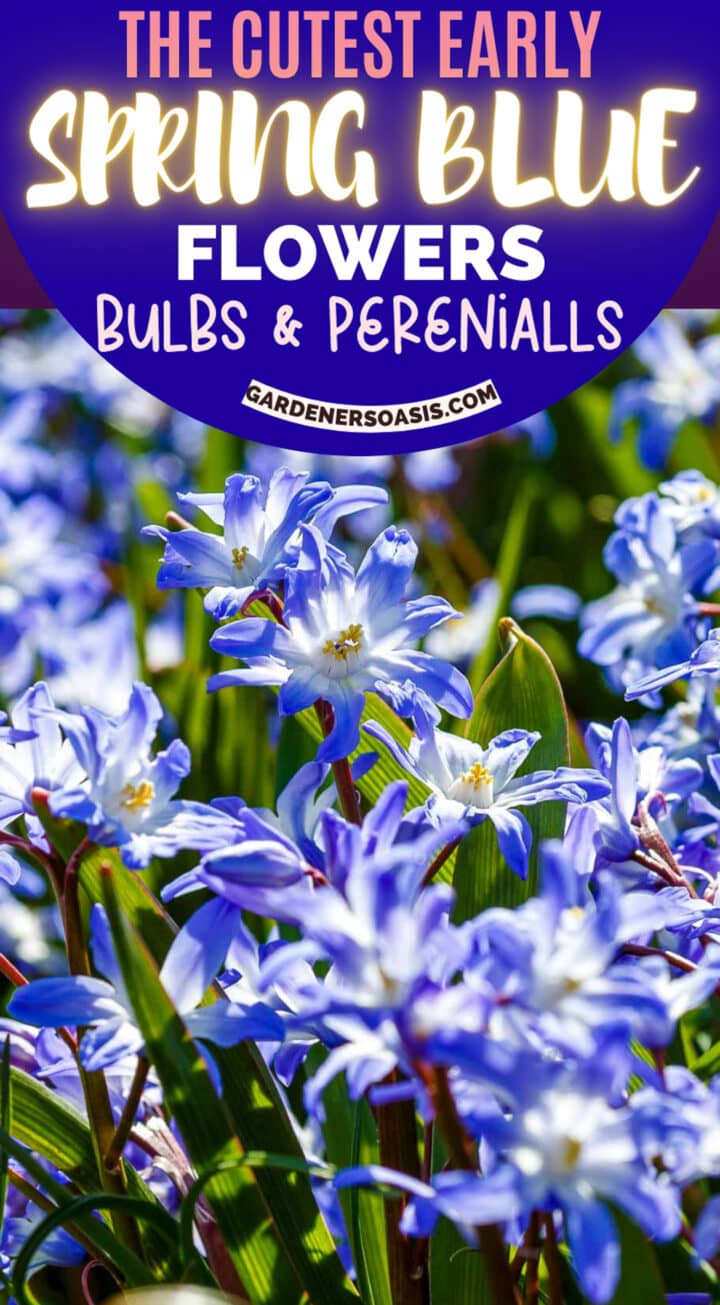Early Spring Blue Flowers (The Best Bulbs And Perennials)
Is there anything better than the emergence of blue flowers in the early springtime? Not only do they add pops of bright color to an otherwise dreary landscape, but they also signify that warmer days are ahead. Here are 10 types of blue flowers that typically bloom in the early spring.
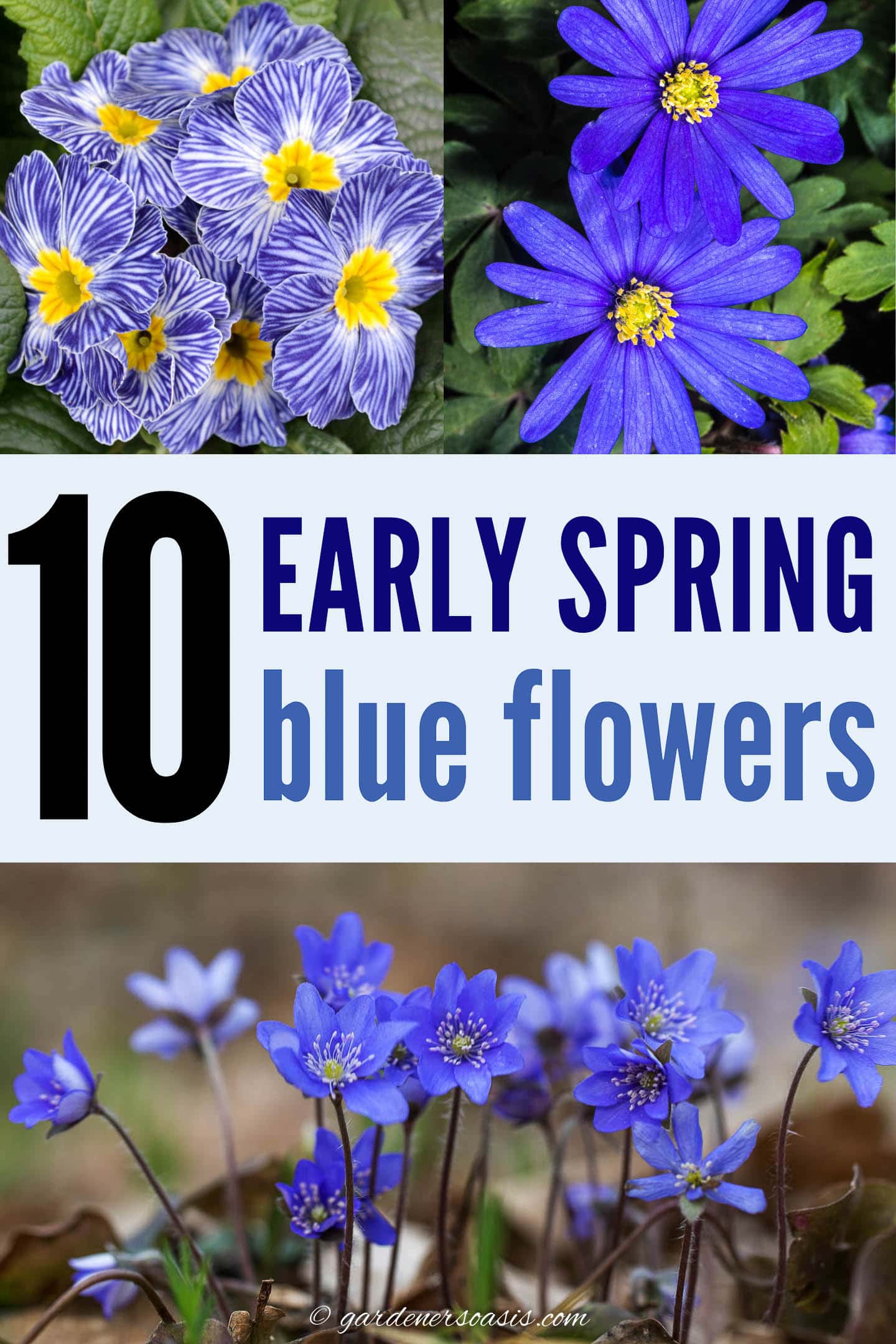
The first plants to bloom after the dormancy of winter are always a welcome sign that stimulates feelings of joy and hope.
For me, anything that comes up blue gives an extra thrilling burst of happiness.
While early spring blue blooming bushes and trees are nonexistent, there are some bulbs and perennials that look marvelous under dormant trees and shrubs and in or around lawns.
If you love blue as much as I do, you will be interested in the list that follows.
Note that many of the early spring blue flowering plants are bulbs that must be planted in the fall so they will bloom the following spring.
1 | Glory-of-the-Snow
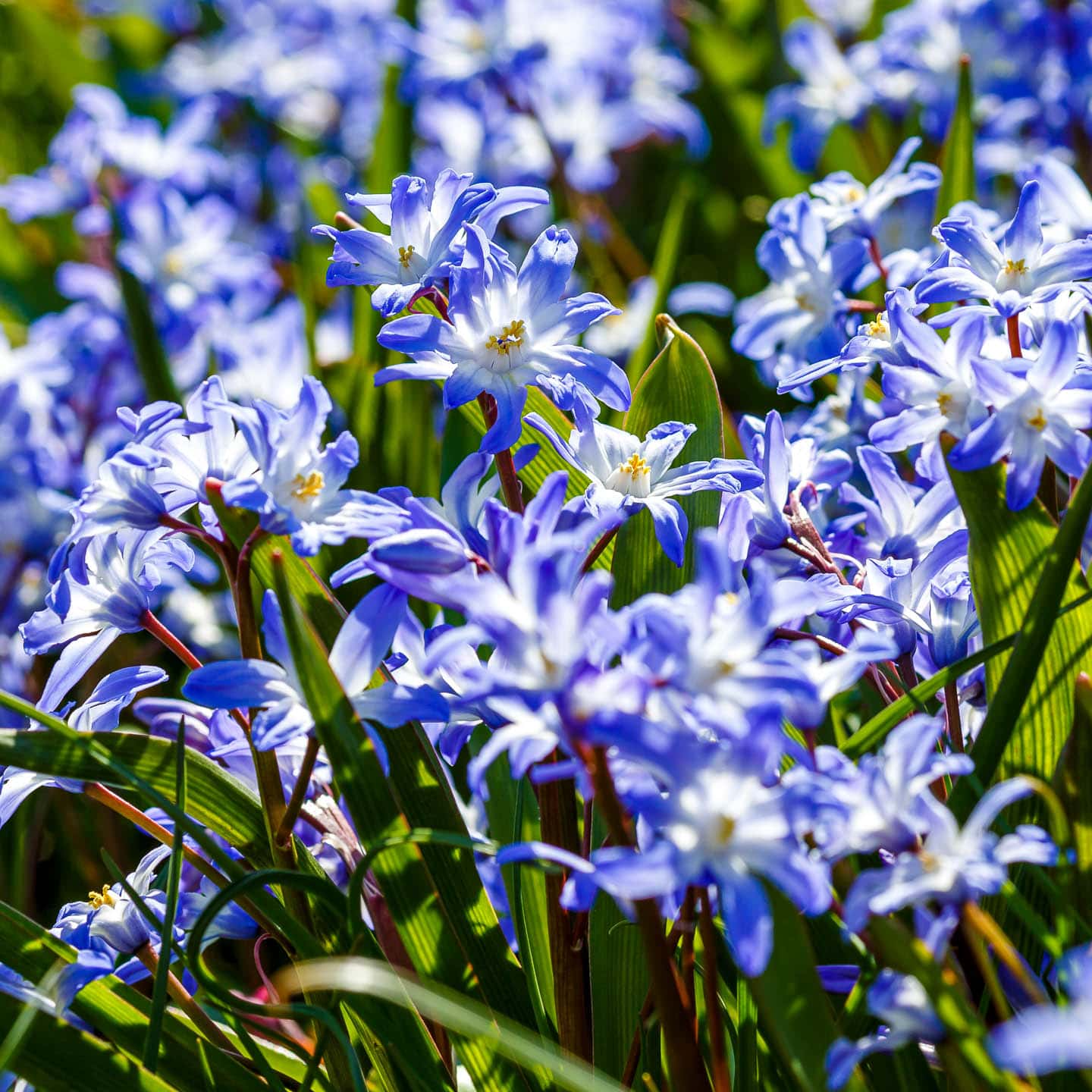
Scientific name: Chionodoxa
Zone: 3 to 9
Exposure: sun, partial shade
Height: 4″ to 10″
Width: 1″ to 2″
Bloom time: early spring
Bloom color: blue
One of the earliest bloomers that pokes its head up through the snow is glory-of-the-snow.
Chionodoxa is an easy to grow bulb that is native to the mountains of Turkey where it is found just at the snow line.
Plant the bulbs in bunches of 5 or 7, in well draining soil, 3″ deep, under trees and shrubs where they will bloom before the green leaves appear in the spring.
They naturalize and also self-seed, so that in a few years you will have a glorious carpet of blue in those barren areas.
Glory of the snow will even grow in the soil around a black walnut tree.
If you plant them in the lawn, do not mow the grass until the foliage dies, to allow the bulbs to rejuvenate for next year.
Glory of the Snow are not prone to disease or pests and repels deer and rodents.
Suggested varieties:
- c. luciliae is the species bulb. It has star shaped blue blooms that sport pale centers.
- c. forbesii ‘Blue Giant' has larger blossoms than the species. The blooms are blue with white centers.
- c. sardensis has larger darker blue flowers than c. luciliae. As well, the centers are blue, not white and sardensis has longer stems.
2 | Siberian squill
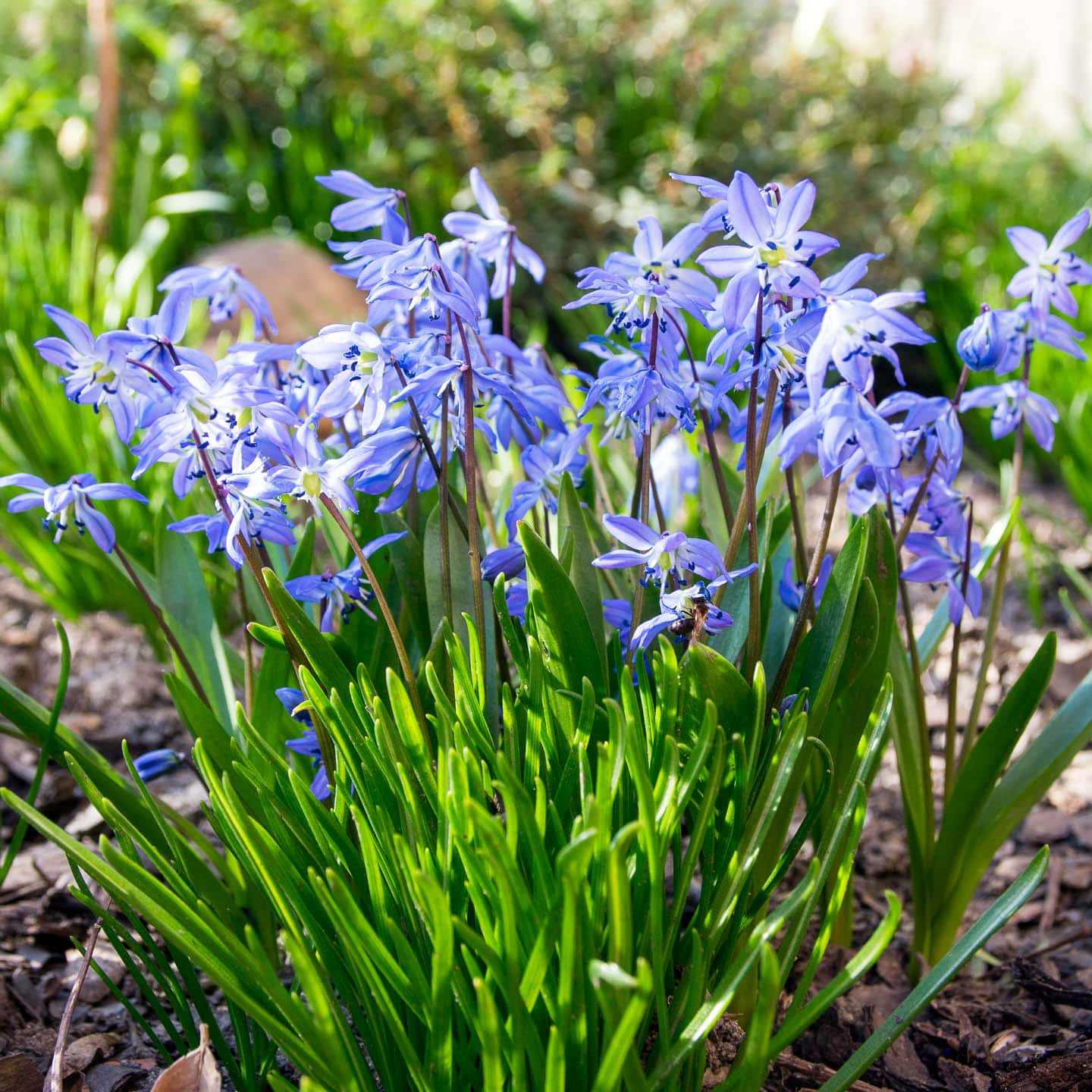
Scientific name: Scilla siberica
Zone: 3 to 9
Exposure: Sun, part sun, or shade
Height: 4″ to 6″
Width: 3″ to 4″
Bloom time: early spring
Bloom color: cobalt blue
Siberian squill is another bulb with small, bell-shaped blue flowers in early spring,
It naturalizes under deciduous trees and bushes to form a lovely sea of blue.
It may also be planted in the lawn, where its grass-like foliage will have turned yellow by the time the grass needs cutting.
This carefree plant needs to be deadheaded after it has finished blooming to prevent unwanted self-seeding and spread.
In the fall, plant the bulbs, in bunches of 10 or so, 4″ deep and 3″ apart in well drained soil.
Scilla is avoided by deer and rodents.
3 | Hyacinth
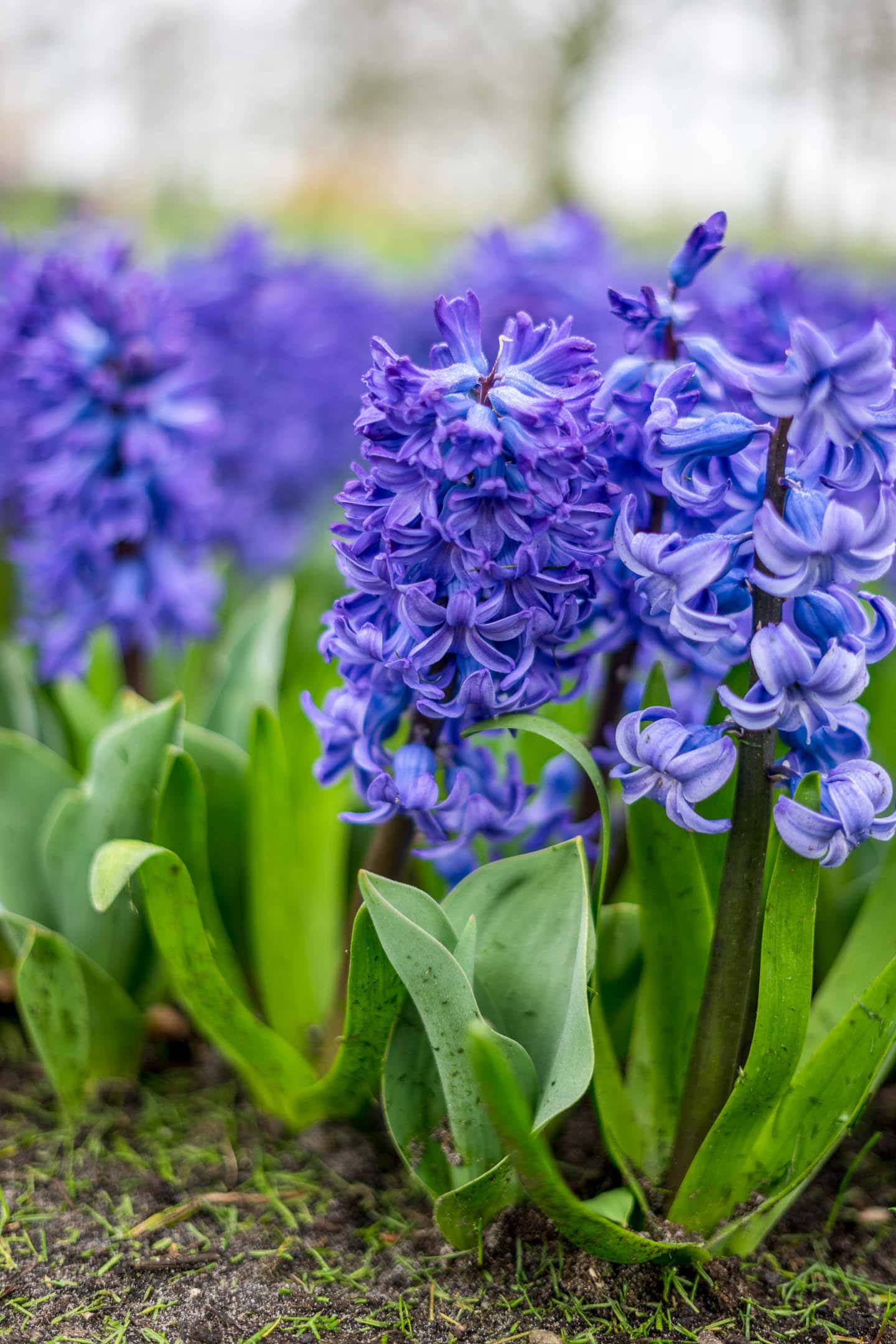
Scientific name: Hyacinthus orientalis
Zone: 4 to 8
Exposure: sun, partial shade
Height: 8″ to 14″
Width: 6′ to 8′
Bloom time: early spring
Bloom color: blue, pink, white, yellow
There are several varieties of hyacinth bulbs with blue spring blooming flowers.
However, some are earlier than others (such as ‘Delft Blue' or ‘. So if you want the earliest bloomers, check the descriptions to get the ones that come up at the right time.
It has a magnificent aroma that fills the whole garden but it is repellant to deer and varmints.
Plant the bulbs in mid to late fall, 6″ deep and 6″ to 8″ apart, in well drained, compost enriched soil, in clumps of 7 to 9 bulbs.
For best appreciation of aroma and beauty, cite them at the front of the perennial border or near paths.
Avoid planting in singles, or straight rows to keep the aesthetic pleasing.
The blooms may need to be staked with a thin bamboo stick, but if planted as described the blossoms will support each other.
Many gardeners treat hyacinths as annuals. If the foliage is allowed to die back naturally, the bulbs will bloom next year. However, the blossoms will be smaller and not true to form.
Suggested varieties:
- ‘Delft Blue'
- ‘Royal Navy Double'
4 | Reticulated iris
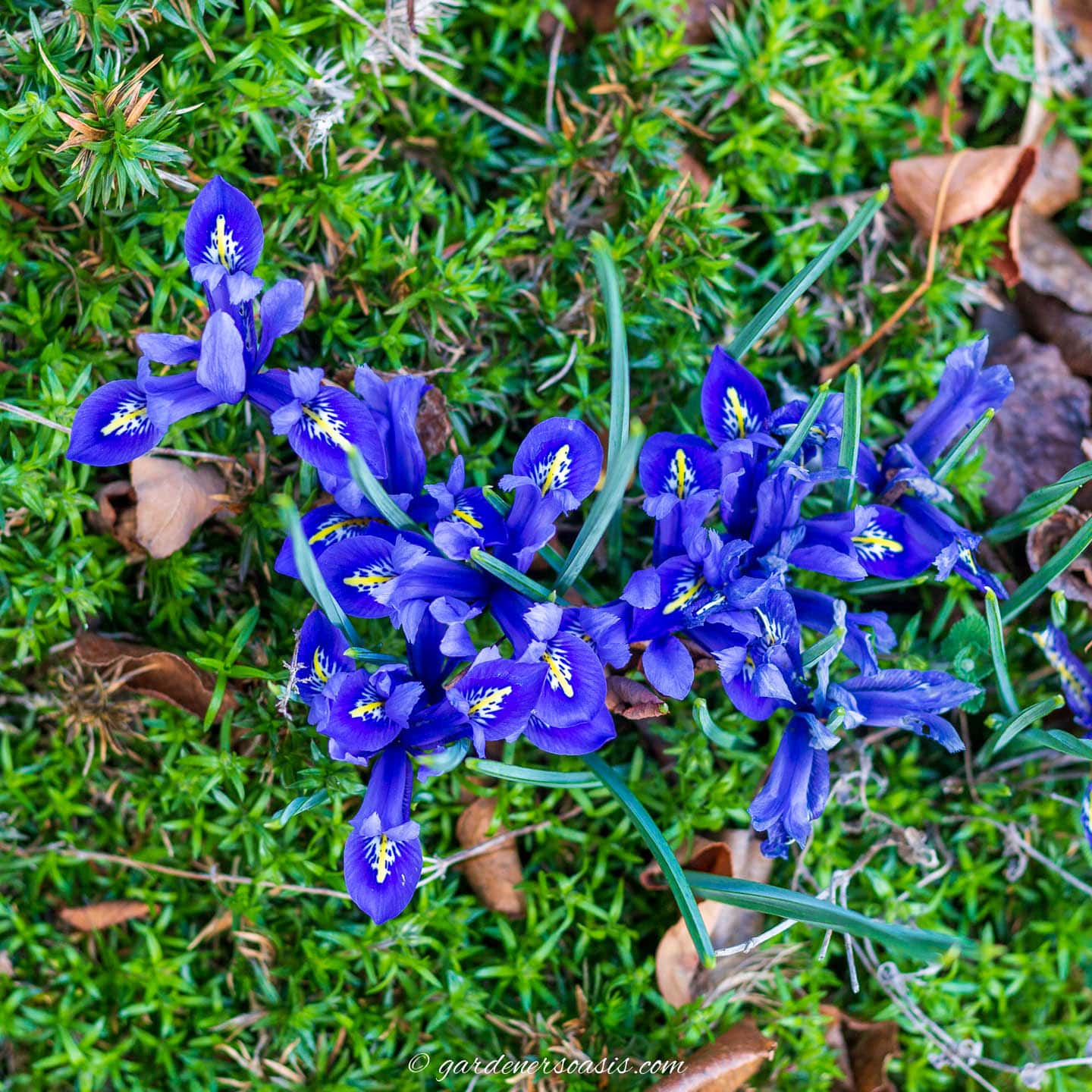
Scientific name: Iris reticulata
Zone: 3 to 9
Exposure: Sun, part shade
Height: 4″
Width: 3″
Bloom time: early spring
Bloom color: bright, cobalt blue with yellow and white center markings
I just love the cheerful arrival of Iris reticulata in early spring. These small plants pack a whollop of delicate perfume and visual delight.
Plant in well drained soil, 4″ deep and 3″ apart in groups, with the pointy end of the bulb up.
The grass like foliage should be removed when it turns brown after the plant has finished blooming. Iris reticulata will naturalize slowly over the years.
They are drought and deer tolerant.
Suggested varieties:
- ‘Harmony'
- ‘Alida dwarf'
- ‘Frank Elder' — very early bloomer with sky blue flowers
5 | Starflower
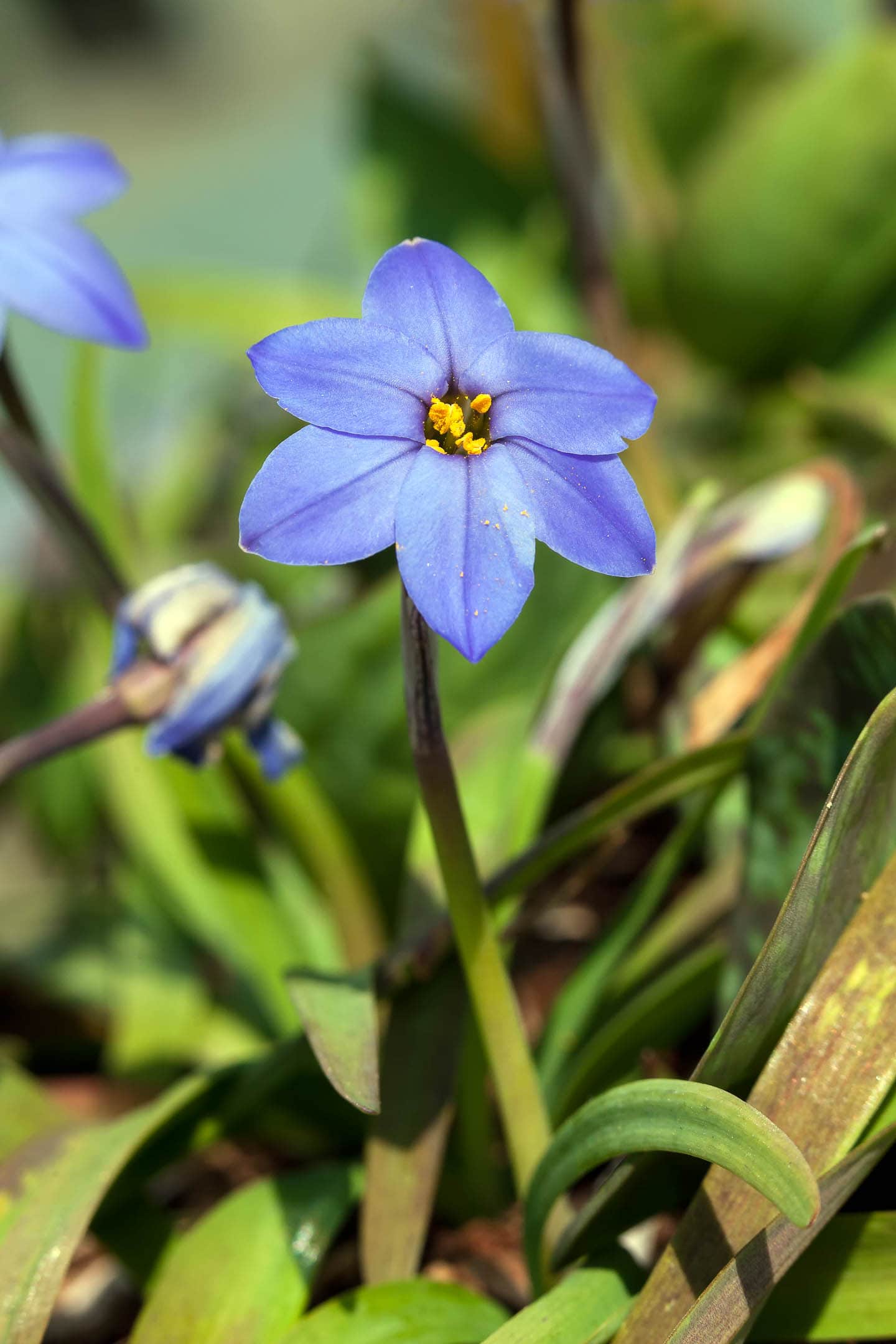
Scientific name: Ipheion uniflorum
Zone: 5 – 9
Exposure: sun, part shade
Height: 6″
Width: 6″
Bloom time: early spring
Bloom color: pale blue with dark blue stripe
Ipheion uniforum has a sweetly scented blue, star-shaped flower with slender, deep green foliage that smells like onions when crushed.
Each bulb produces several flowering stems that keep blooming until the weather heats up.
The seed heads can be removed to prevent invasive self-seeding.
The plant clumps can be divided every year or 2 for the same reason.
In the fall, plant the bulbs en masse, 2″ deep and 2″ apart and cover with mulch. Remove the mulch in the spring when green shoots appear.
This native of Uruguay and Argentina is tolerant of deer and rabbits and isn't very attractive to squirrels. It will also grow under black walnut trees.
Suggested varieties:
- ‘Rolf Fiedler' — intense blue aromatic flowers with more rounded petals.
- ‘Jessie' — the darkest blue of all the starflower cultivars, and its a long bloomer, too. Jessie's flowers last 8 weeks.
6 | Grecian windflower
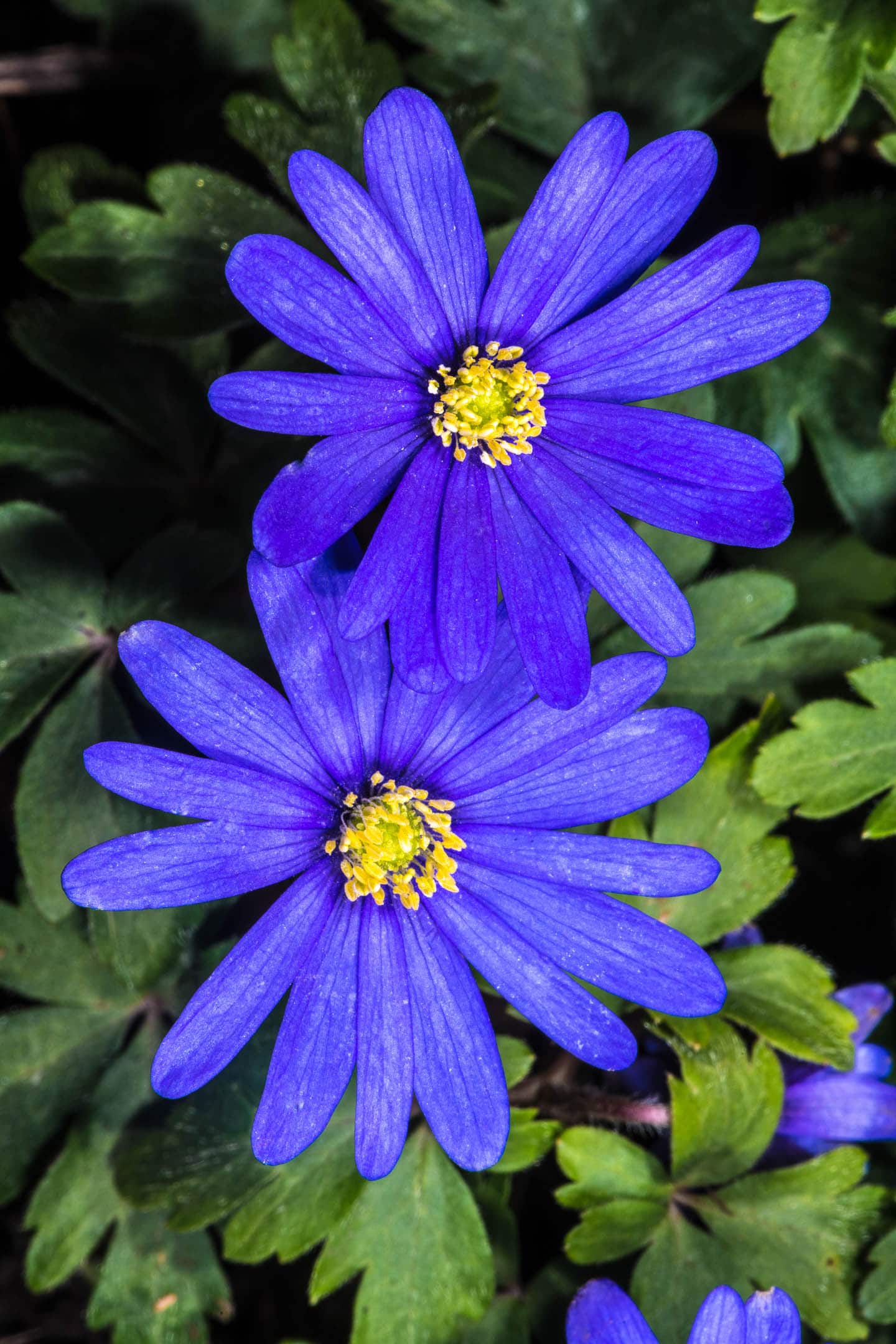
Scientific name: Anemone blanda blue
Zone: 4 to 10
Exposure: full sun to part shade
Height: up to 6″
Width: 4′ to 6″
Bloom time: early spring
Bloom color: blue, pink, white and bicolor
Plant the hard, lumpy tuber in the fall for a profuse display of early spring daisy-like blooms that hide the ferny foliage for weeks.
Charming Grecian windflower likes moist, well drained, rich soil and is best planted at the front of the border where its dainty display of flowers can be appreciated.
Allow the foliage to die back naturally.
Plant the corms 3″ deep and 2″ to 3″ apart beside later blooming perennials for continuity of bloom in the garden.
This plant will naturalize by expanding every year and can act like a ground cover until it goes dormant.
It is resistant of rabbits and deer.
All parts of the plant are toxic to humans and pets.
7 | Striped Squill
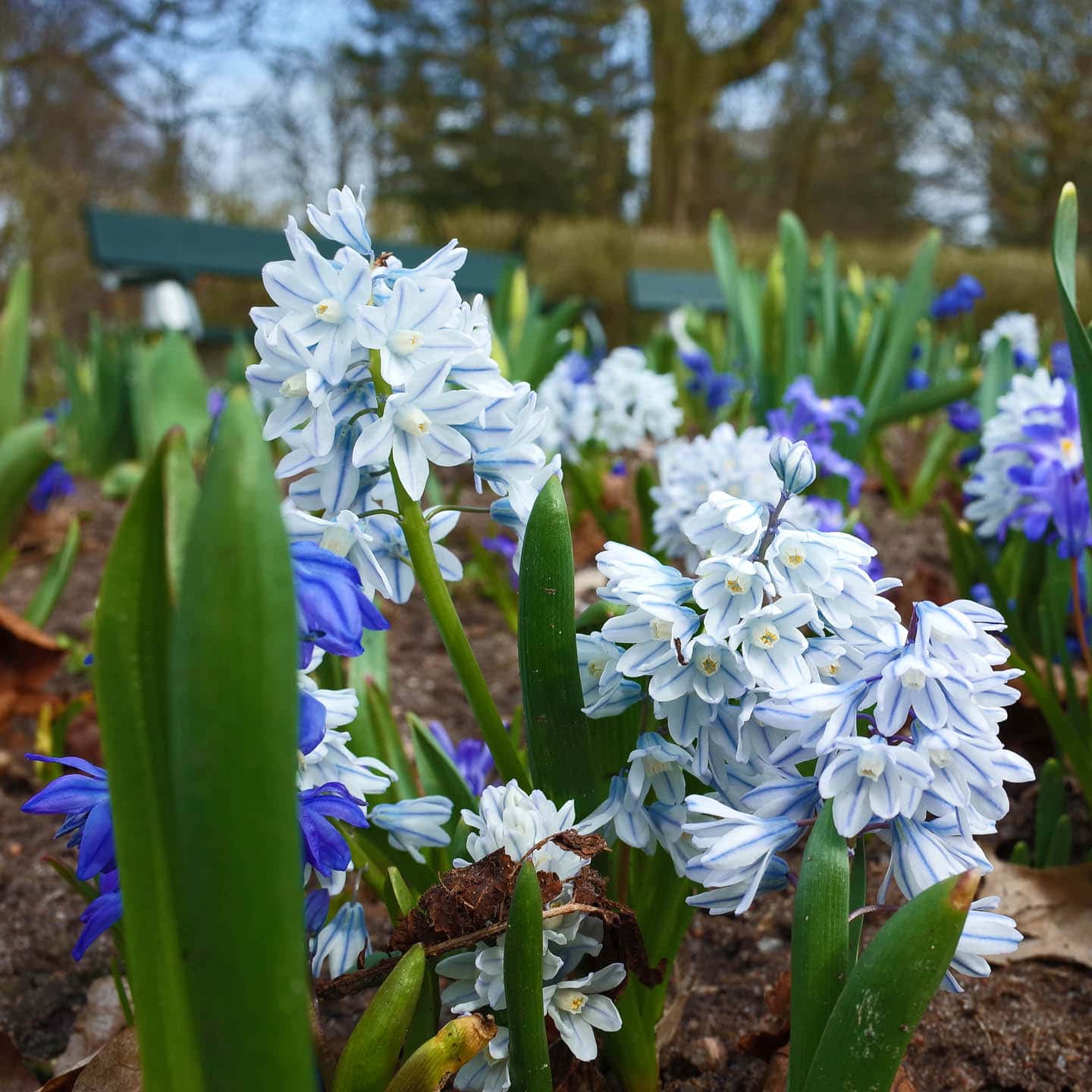
Scientific name: Puschkinia libanotica
Zone: 3 to 8
Exposure: Full sun to part shade
Height: 6″ to 8″
Width: 6″ to 8″
Bloom time: late winter to early spring
Bloom color: blue and white
Striped squill is a small bulb in the asparagus family that mixes well with other spring-flowering bulbs.
It can either have white flowers with blue stripes or be totally blue. In both cases, the blooms are fragrant and do very well in rock gardens.
Plant the bulbs in a 2 to 3 inch hole with about 6 inches between each bulb.
They will naturalize by both self-seeding and bulb offsets. Deadhead the flowers to keep it from seeding and spreading too fast.
Deer don't like Puschkinia and it will grow under black walnut trees.
8 | Liverwort
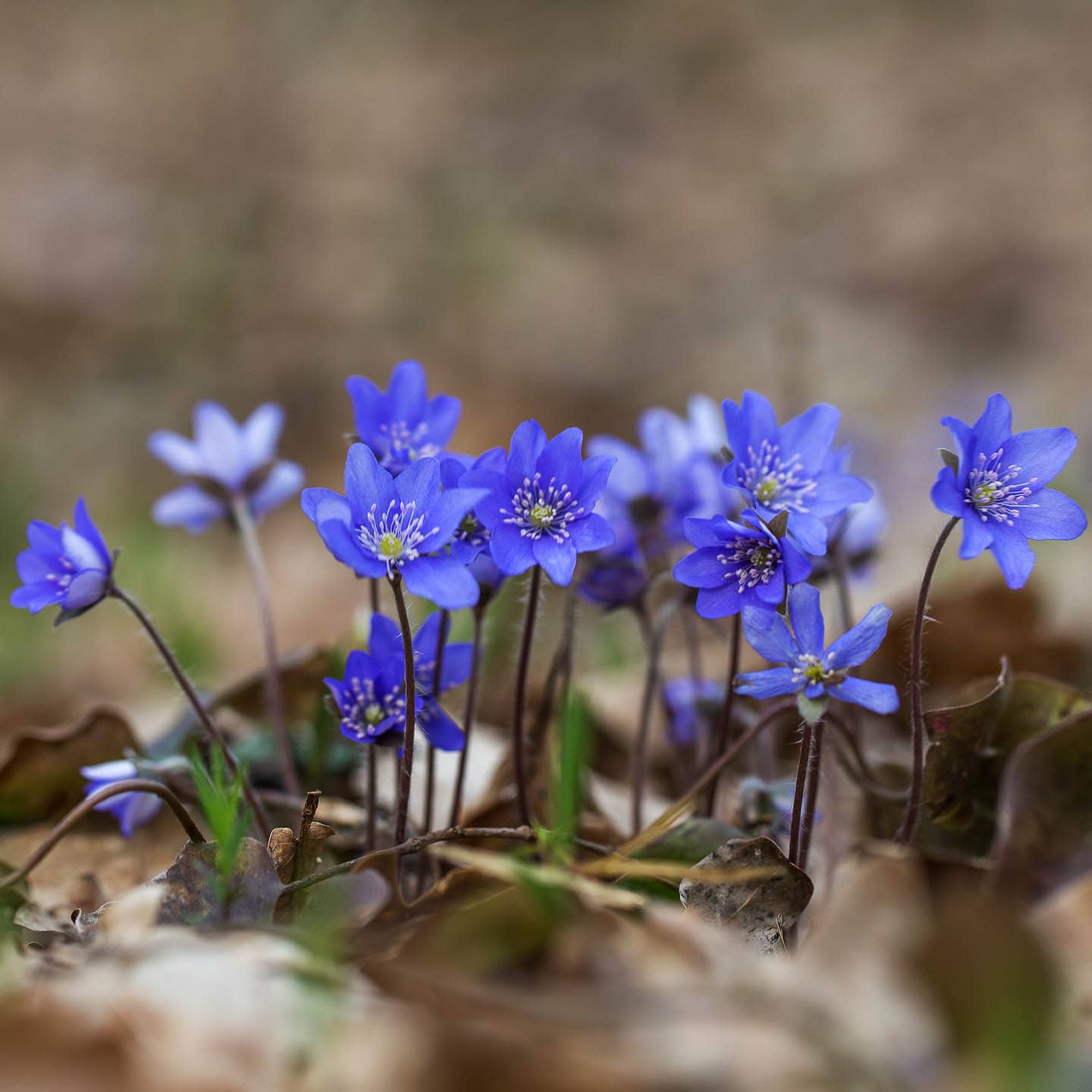
Scientific name: Hepatica nobilis
Zone: 4 to 9
Exposure: part shade to full shade
Height: 4″ to 6″
Width: 6″ to 9″
Bloom time: early through mid spring
Bloom color: blue, white or pink
Liverwort is a one of the spring's earliest native woodland plants that can cover the ground with its small blue wildflowers in early spring.
It has bright blue, lavender, pink or white blooms with evergreen leaves.
It is very easy to grow and has a fresh, delicate scent that smells like spring.
The flowers may not fully open on a rainy day but even the half-opened flowers are a bright spot in the garden.
Primrose
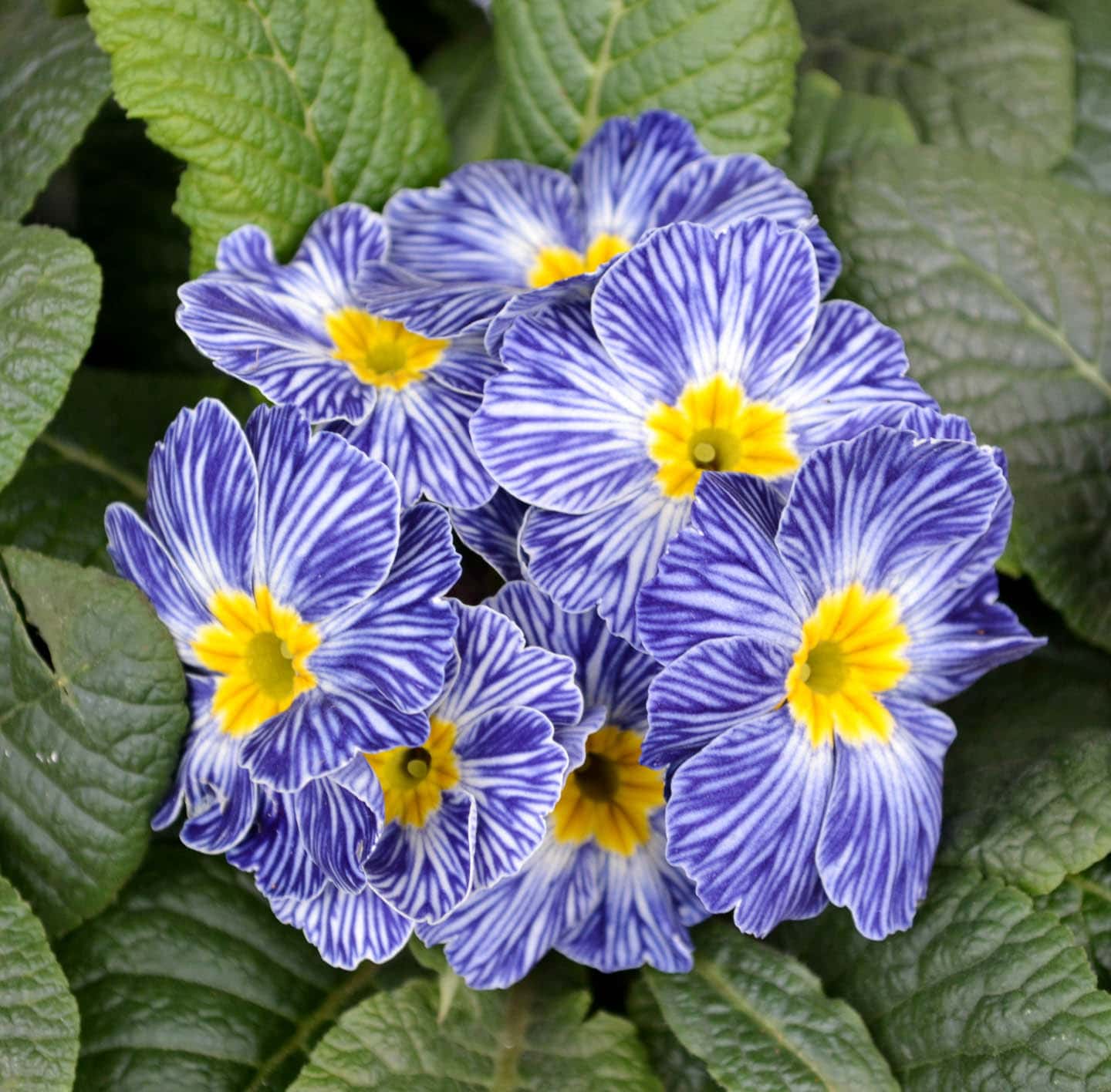
Scientific name: Primula
Zone: 4 to 8
Exposure: part shade to full shade
Height: 6″ to 8″
Width: 8″ to 10″
Bloom time: late winter through early to late spring
Bloom color: blue with white stripes
There are quite a few Primula cultivars with early blue flowers. They are often fragrant with bright yellow centers.
Plant in moist, humus rich soil about 10″ apart.
This long bloomer — from winter through spring — looks great under shrubs or roses or in containers. It will go dormant in warm summer weather but may reappear and bloom again in the fall.
It needs regular dead heading.
Deer and rabbits are not attracted to primrose.
Suggested varieties:
- ‘Belarina cobalt blue' blooms profusely on a compact nest of semi evergreen foliage.
- ‘Zebra Blue' has blue and white striped blossoms with a yellow center (see the picture above)
10 | Pansies
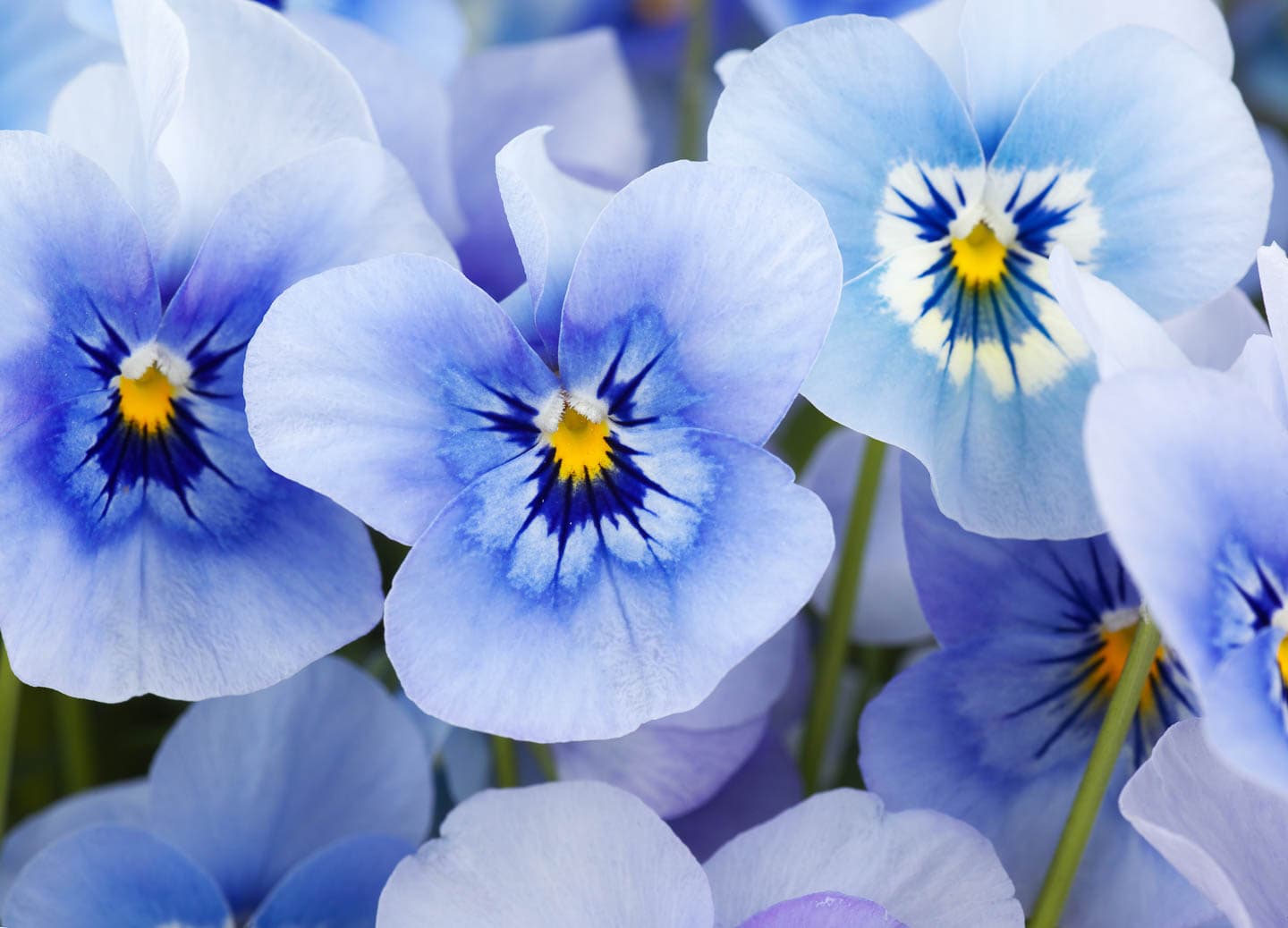
Scientific name: Viola tricolor
Zone: Annual in most areas, short-lived perennial in zones 9 to 11 where the summers aren't too hot.
Exposure: sun, part sun
Height: 6″ – 9″
Width: 4″ to 12″
Bloom time: spring, fall
Bloom color: blue and most other colors
Pansies are a cheerful little flower that come in strikingly beautiful blue and light blue colors.
They are cool weather plants that do best when the soil temperature is between 45ºF and 65ºF.
Pansies will bloom all winter in warmer climates if planted in the fall, but become very leggy when the temperature rises in late spring. They then need to be replaced by more heat tolerant annuals.
Pansies need regular watering and feeding with a low nitrogen water soluble fertilizer every 3 weeks.
Dead head to prolong bloom time.
They do well in pots and window boxes or mass planted in beds.
Suggested varieties:
- ‘blue and purple rain' — an award winner that ages from white to blue and purple.
- ‘delta marina' — true blue color with dark blue center surrounded by paler blue outer edges.
You can find them at most nurseries and garden centers.
Other spring garden ideas you might like
- Early spring purple flowers
- Yellow flowers for early spring
- Early spring white flowering trees
- The earliest spring flowering plants
- How to get your garden ready for spring
- 8 plants to combine with spring bulbs
Have comments or suggestions about our early spring blue flowers? Tell us in the section below.
This post was originally published on February 23, 2022 but was updated with new content on November 23, 2024.

